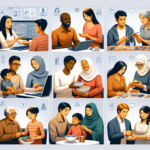Free Diapers Assistance Program & Resources for Low-Income Families

Struggling to Afford Diapers: The Plight of Low-Income Families
Imagine you’re a parent, and every penny counts. You’re faced with the choice between buying food or diapers. This is a reality for many families. Diapers are not a luxury; they are a necessity for a child’s health and well-being. Yet, the cost can be overwhelming for those with limited resources.
Key Takeaways: Quick Facts about Diaper Need and Assistance Programs
-
Diapers can cost $70 to $80 per month per baby, which adds up quickly.
-
1 in 3 families in the U.S. report experiencing diaper need.
-
There are resources like diaper banks and federal programs to help.
-
Eligibility for diaper assistance varies, but it’s often based on income.
-
Community support is crucial – donations and volunteering can make a big difference.
Diaper Cost Analysis: Why Affordability is a Challenge
Let’s break down the numbers. Diapers can cost a family about $70 to $80 monthly per baby. That’s nearly $1,000 a year, a significant portion of a low-income family’s budget. And diapers can’t be bought with food stamps or most federal assistance programs, making them an out-of-pocket expense that many families struggle with.
-
A single baby uses 6-12 diapers a day, which can add up to more than 2,000 diapers a year.
-
Specialty diapers, such as hypoallergenic options, can be even more expensive.
-
Unlike other essentials like food, diapers are taxed in many states, adding to the cost.
-
Buying in bulk is often cheaper per diaper, but the upfront cost is higher, which can be prohibitive for families living paycheck to paycheck.
-
Cloth diapers may seem like a cost-effective solution, but they require access to laundry facilities, which not all families have.
Unwrapping Diaper Assistance: Resources for Parents in Need
Now, let’s talk solutions. If you’re struggling to afford diapers, know that you’re not alone and there are resources out there designed to help you. Diaper banks are a great starting point. They collect, store, and distribute free diapers to families in need. Many are part of the National Diaper Bank Network, a group that’s working to ensure that all babies have access to clean diapers.
Eligibility Requirements: Who Qualifies for Free Diapers?
Who gets help? Generally, if you’re a low-income family, receiving government assistance, or in a tough spot financially, you could qualify for diaper assistance. Each diaper bank and assistance program has its own set of criteria, but they’re all focused on helping those who need it most.
Here’s a quick look at typical eligibility criteria:
-
Proof of income or enrollment in assistance programs like WIC or SNAP.
-
Identification for you and your child, such as a birth certificate or social security card.
-
Occasionally, a referral from a social service agency or healthcare provider is needed.
-
Some programs have specific geographic requirements, serving only certain cities or counties.
Finding Help Nearby: Locating Diaper Banks and Other Resources
So where do you find these diaper banks? Start with the National Diaper Bank Network’s online directory. It’s a fantastic tool that lets you search for diaper assistance programs in your area. Don’t forget to reach out to local food pantries and community organizations as well, as they often have diapers available or can direct you to additional resources.
Remember, the goal here is to get you the help you need, so don’t hesitate to ask around and utilize these resources. Your child’s health and happiness are what matter most.
Understanding Federal and State Aid for Diapers
While diapers are essential for babies, they’re not covered by most federal aid programs. This is where the confusion often lies. Federal and state aid can still play a role in helping families afford diapers indirectly, by covering other expenses or providing cash assistance that can be used to purchase diapers.
National Diaper Bank Network: A Safety Net for Families
The National Diaper Bank Network (NDBN) is a godsend for many families. It’s a nationwide network that connects and supports over 200 community-based diaper banks. The NDBN helps these diaper banks collect and distribute millions of diapers to families in need each year. They work tirelessly to raise awareness of diaper need and advocate for policy reform to help families access the diapers they need to keep their babies clean, dry, and healthy.
Did you know? The NDBN reports that it helped distribute over 52 million diapers to more than 1.3 million children in a single year.
Public Assistance Options: WIC and SNAP Explained
Let’s clarify some misconceptions about WIC and SNAP. The Special Supplemental Nutrition Program for Women, Infants, and Children (WIC) provides federal grants to states for supplemental foods, health care referrals, and nutrition education for low-income pregnant, breastfeeding, and non-breastfeeding postpartum women, and to infants and children up to age five who are found to be at nutritional risk. SNAP, on the other hand, offers nutrition assistance to millions of eligible, low-income individuals and families. However, neither program covers diapers directly, which is why diaper banks and community programs are so vital.
-
WIC and SNAP can free up funds in a family’s budget that can then be allocated to diaper purchases.
-
Some states have programs or initiatives that provide cash assistance which can be used for diapers.
-
Advocacy groups are working to include diapers as a covered necessity in these federal programs.
Leveraging Community Support for Diaper Distribution
Community support is the backbone of diaper distribution. Local organizations often step in to fill the gap left by federal programs. They understand the community’s needs and can provide personalized support to families.
Local Food Banks’ Role in Diaper Assistance
Food banks are not just about food. Many also offer diapers to families in need. They understand that if a family is struggling to put food on the table, they’re likely struggling to buy diapers too. By offering both in one place, food banks make it easier for parents to get the essentials they need to care for their children.
-
Many food banks have specific days or programs dedicated to diaper distribution.
-
Some food banks partner with local diaper banks to ensure a steady supply of diapers.
-
Volunteers are crucial to these operations, helping to organize and distribute diapers to families.
Charitable Organizations Offering Diaper Relief
Apart from food banks, there are numerous charitable organizations that recognize the importance of providing diaper assistance to families. Organizations like Catholic Charities, United Way, and Salvation Army often have programs or partnerships with diaper banks to help distribute diapers to those in need.
-
These organizations may also provide other baby supplies, such as wipes and formula.
-
Charitable programs often have broader eligibility criteria, making it easier for families to get help.
-
They also serve as great resources for information on other assistance programs available in the community.
Remember, these organizations are here to help you. Don’t hesitate to reach out to them if you’re in need of diapers for your baby. They understand the challenges you’re facing and will do their best to support you and your little one.
Maximizing Program Benefits and Minimizing Stigma
Now, let’s tackle a big hurdle – the stigma. There’s no shame in seeking help when you need it, especially when it comes to caring for your children. Remember, these programs are designed to support you and your family’s well-being.
How to Apply for Diaper Assistance Without Shame
Applying for assistance is a step towards stability, not a sign of weakness. Be prepared with the necessary documents, like proof of income and identification, and remember that the staff at these organizations are there to help, not judge. They’ve seen it all and are passionate about supporting families just like yours.
-
Reach out to the diaper bank or organization and ask about the application process.
-
Gather all required documentation before applying to streamline the process.
-
Ask questions if you’re unsure about anything – the staff are there to assist you.
-
Remember, you’re taking a responsible step for your child’s health – that’s commendable.
Overcoming Barriers to Access: Tips and Tricks for Parents
Accessibility can be a challenge, but there are ways to navigate these waters. If transportation is an issue, look for programs that offer delivery or partner with organizations that do. If language is a barrier, seek out assistance programs with multilingual staff or bring along a friend or family member who can translate.
-
Check if the diaper bank has a delivery service if you can’t get there in person.
-
Use community resources like libraries or community centers for help with applications.
-
Connect with other parents who can share their experiences and tips.
-
Don’t be afraid to reach out to multiple organizations – each may offer different types of help.
Exemplary Programs Making a Difference
Across the country, there are shining examples of programs that are making a real impact on diaper need. These initiatives not only provide diapers but also work towards long-term solutions and community building.
Spotlight on Successful Diaper Distribution Initiatives
Take, for example, the ‘Diaper Circle’ program in Boston, which not only distributes diapers but also offers parenting classes and a support network for families. Or the ‘Baby2Baby’ program in Los Angeles, which provides low-income children with diapers, clothing, and all the basic necessities that every child deserves.
Success Story: A mother in Atlanta was able to go back to work because a local diaper bank provided her with a month’s supply of diapers, giving her the peace of mind that her baby was taken care of while she worked to support her family.
Transitional Stories: From Diaper Need to Diaper Security
Stories abound of parents who have gone from the stress of diaper need to the relief of diaper security. These narratives are powerful reminders of the impact that these programs have on individual lives. Parents often report reduced stress, improved child health, and the ability to allocate funds to other essential needs.
-
One family was able to save enough money to move into a safer neighborhood because they no longer had to worry about the cost of diapers.
-
A father shared how receiving diaper assistance allowed him to take a higher-paying job with a longer commute, as he could now afford the transportation costs.
-
Diaper assistance has helped many families avoid having to choose between buying diapers and paying for utilities or rent.
These success stories are not just heartwarming – they’re a testament to the importance and effectiveness of diaper assistance programs. They empower families to take control of their situation and provide a healthier environment for their children to grow up in.
Extending Support Beyond Diapers
Diapers are just the start. Families often need comprehensive support that goes beyond the basics. Thankfully, many diaper assistance programs are part of larger organizations that provide a range of services and resources for low-income families.
Additional Parenting Resources for Low-Income Families
Many organizations that offer diaper assistance also provide other essential items such as baby formula, clothing, and gear. They may also offer access to parenting classes, nutrition advice, and even employment support services. These additional resources can be a lifeline for parents trying to provide the best for their children.
-
Parenting classes can help you learn valuable skills and strategies to support your child’s development.
-
Nutrition programs ensure that both you and your baby have access to healthy food choices.
-
Employment services can assist you in finding a job or improving your work situation to better support your family.
-
Some programs offer mental health support, recognizing the emotional challenges that come with parenting, especially under financial strain.
Comprehensive Aid: From Diapering to Childcare
For many families, childcare is another significant expense. Some diaper assistance programs recognize this and collaborate with childcare providers to offer reduced rates or prioritize spots for low-income families. By addressing the bigger picture, these programs help parents not only care for their babies but also pursue opportunities for their own growth and stability.
-
Look for programs that offer a holistic approach to family support, including childcare options.
-
Ask about sliding scale fees for childcare based on income, which can make quality care more affordable.
-
Some organizations provide referrals to trusted childcare providers within the community.
The Path Forward: Advocating for Expanded Diaper Assistance
While there is support available, the need for diapers outpaces the current supply. That’s why advocacy for expanded diaper assistance is crucial. By raising our voices, we can work towards systemic change that ensures all families have access to the diapers they need.
Policy and Advocacy: Striving for Legislative Change
Advocates are pushing for policy changes that would include diapers as a covered necessity in federal aid programs. They’re also working to eliminate sales tax on diapers, which can make a significant difference in affordability. By engaging with legislators and raising public awareness, we can create a groundswell of support for these important changes.
-
Support legislative initiatives that aim to provide federal funding for diaper assistance.
-
Participate in awareness campaigns to highlight the issue of diaper need.
-
Encourage your local representatives to support policies that benefit low-income families with young children.
How Community Involvement Can Bolster Diaper Programs
Community involvement is key to the success of diaper programs. When communities come together, they can create a robust support network for families. This can include diaper drives, fundraising events, and volunteering at local diaper banks. By getting involved, you can help ensure that these vital programs have the resources they need to continue supporting families.
-
Organize or participate in local diaper drives to help stock the shelves of diaper banks.
-
Volunteer your time at a diaper distribution center or offer to help with administrative tasks.
-
Spread the word about diaper need and the importance of these programs in your social circles and online.
Every bit of support counts, and your involvement can make a real difference in the lives of families struggling to provide for their babies. Together, we can build a future where no parent has to choose between buying diapers and other essentials for their children.
FAQ: Addressing Common Queries on Diaper Aid
Can I receive free diapers if I’m already receiving government benefits?
Yes, absolutely! Receiving government benefits does not disqualify you from getting diaper assistance. In fact, being a part of programs like WIC or SNAP may actually make it easier for you to qualify for diaper aid. Diaper banks and assistance programs often work in tandem with government benefits to ensure that your little one’s needs are fully met.
How often can I access free diapers from a diaper bank?
Each diaper bank has its own set of rules, but many offer monthly assistance. Some might have specific distribution days or require an appointment. It’s best to get in touch with your local diaper bank directly to understand their schedule and how often you can receive help. They understand that babies go through diapers quickly, and they aim to provide consistent support.
What documentation do I need to provide to receive diaper assistance?
Be prepared to show some documentation when you apply for diaper assistance. Commonly required documents include:



